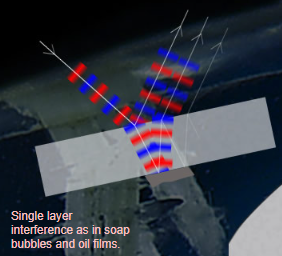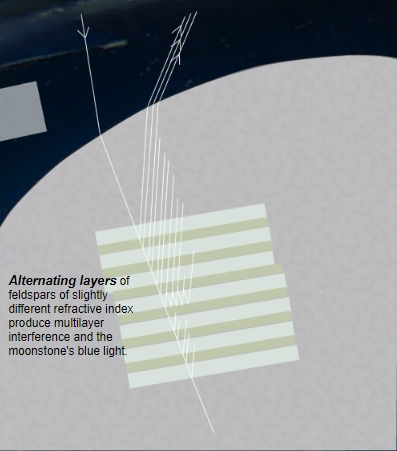Moonstone Adularescence - OPOD
Moonstone Adularescence: A Captivating Natural Phenomenon
Moonstones, with their colorless, milky white, and occasionally grey or peach hues, possess a captivating optical phenomenon known as adularescence or schiller. This mesmerizing display of gentle blue light emanates from deep within the stone when viewed from certain angles. Unlike an intrinsic mineral color, adularescence is a form of iridescence that arises from multi-layer interference. In this article, we will delve deeper into the fascinating world of moonstone adularescence and explore the scientific principles behind this enchanting phenomenon.
Moonstones are a type of feldspar, which is a complex sodium potassium aluminum silicate mineral. Within the structure of moonstone, there exist alternating layers of slightly different compositions. These distinct layers give rise to the interference color observed in adularescence. The compositional extremes of feldspars are albite (sodium-rich) and orthoclase (potassium-rich), and as the feldspar melt cools, albite solidifies first, leaving behind a neighboring potassium-rich liquid that eventually solidifies into orthoclase. This process leads to the formation of a regular stack of alternating layers, each less than a micron thick, composed of sodium-rich and potassium-rich material.
The alternating layers of moonstone possess slightly different optical properties. When light passes through these layers, it is reflected and refracted at their interfaces. The reflected light waves then interfere with each other, resulting in the mesmerizing adularescence colors. To better understand the interference mechanism, we can examine what occurs in a single thin layer, such as a soap bubble or an oil film. When light strikes the layer, a portion is reflected from the front surface, while another portion enters the film, reflects off the rear surface, and exits in the same direction as the front reflected wave. The combination of these outgoing waves determines whether there is constructive or destructive interference, resulting in the observed interference colors.
While the phenomenon of interference is evident in single-layer structures like soap bubbles and oil films, the effect is significantly enhanced in moonstones due to the presence of multiple layers with regular spacing and thickness. As light traverses through the moonstone, it undergoes several reflections between these layers, each offering the possibility of interference. The resulting light that exits the structure is a culmination of these multiple reflections, leading to the captivating blue coloration that characterizes moonstone adularescence.
It is worth noting that multilayer interference is not exclusive to moonstones. This phenomenon also manifests in other minerals such as labradorite, opal, and tiger's eye, as well as in the lustrous and pastel colors observed in seashells. The specific layer thicknesses and spacing within each material dictate the unique colors exhibited through multilayer interference.
Moonstone adularescence serves as a testament to the intricate beauty found within the natural world. The interplay of light and matter in moonstones captivates our senses, drawing us into a realm of ethereal blue hues. As we marvel at the shimmering radiance of these gemstones, we are reminded of the wonders that await discovery within the depths of our planet's geological treasures.
In conclusion, moonstone adularescence is a captivating optical phenomenon that arises from multi-layer interference within the structure of moonstones. Through a complex interplay of alternating layers and reflections, moonstones exhibit a mesmerizing blue light when viewed from specific angles. This phenomenon finds its roots in the unique composition and optical properties of feldspars, with moonstones being just one example of materials that showcase multilayer interference. As we continue to explore and appreciate the natural world around us, let us marvel at the enchanting allure of moonstone adularescence and the secrets it unveils.
Moonstone Adularescence
Imaged by Bob Fosbury (flickr). A gentle blue light called adularescence or schiller shines from deep inside the stone.
©Bob Fosbury, shown with permission

Moonstones are colourless, milky white or sometimes grey or peach coloured. The prized blue adularescence or schiller - comes from deep within the stone when it is viewed at certain angles. It is not an intrinsic mineral colour. It is instead a form of iridescence arising from multi-layer interference.
Moonstone is a feldspar. Within the stone there are alternating layers of slightly different composition and these give rise to the interference colour.
Feldspars are complex sodium potassium aluminium silicates. Albite (sodium rich) and orthoclase (potassium rich) are compositional extremes or end members of feldspars. As a feldspar melt cools, albite is the first to solidify leaving an adjacent potassium rich liquid which then forms an orthoclase tending solid. That in turn leaves an adjacent albite rich liquid. And so on.. ..The outcome can be a regular stack of alternating layers each less than a micron thick of sodium rich and potassium rich material.
The alternating layers have slightly different optical properties. Light passing through them is reflected and refracted at their interfaces. The reflected light waves interfere to produce the adularescence colours.
The interference mechanism is more easily understood by looking at what happens at a single thin layer as in a soap bubble or oil film. Light striking the layer is part reflected from the front surface. Another part enters the film, reflects off the rear surface and leaves in the same direction as the front reflected wave. The two outgoing waves combine. If their wave crests - see far left - coincide then there is light in that direction. When they are out of phase there is destructive interference. The phase condition is wavelength dependent with the result that we see interference colours.
The effect is much enhanced when there are multiple layers of regular spacing and thickness. The light leaving the structure is then the outcome of several reflections between layers, each with interference possibilities. We see moonstone blue because of the particular layer thicknesses and spacing.
Multilayer interference gives colours in other minerals, labradorite, opal, tiger�s eye and in the lustrous and pastel colours of sea shells.

Single layer interference as in soap bubbles and oil films.

Alternating layers of feldspars of slightly different refractive index produce multilayer interference and the moonstone's blue light.
Note: this article has been automatically converted from the old site and may not appear as intended. You can find the original article here.
Reference Atmospheric Optics
If you use any of the definitions, information, or data presented on Atmospheric Optics, please copy the link or reference below to properly credit us as the reference source. Thank you!
-
<a href="https://atoptics.co.uk/blog/moonstone-adularescence-opod/">Moonstone Adularescence - OPOD</a>
-
"Moonstone Adularescence - OPOD". Atmospheric Optics. Accessed on November 26, 2024. https://atoptics.co.uk/blog/moonstone-adularescence-opod/.
-
"Moonstone Adularescence - OPOD". Atmospheric Optics, https://atoptics.co.uk/blog/moonstone-adularescence-opod/. Accessed 26 November, 2024
-
Moonstone Adularescence - OPOD. Atmospheric Optics. Retrieved from https://atoptics.co.uk/blog/moonstone-adularescence-opod/.